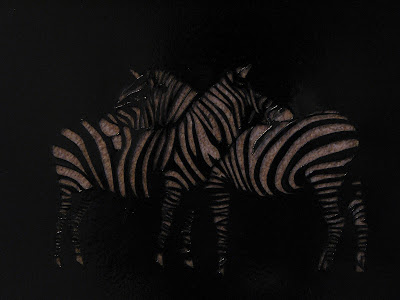This my experiment of using spray paint for my illustration project
I took my picture of zebras into Photoshop and increased the threshold level so the image was in black an white, making it easier to see which parts I would need to cut out for the stencil. I then traced over them and stuck the piece of paper on top of a piece of white card so i could then start cutting out the stencil.
When I finished I placed the stencil on top of white paper and sprayed over it with a can of black spray paint.
I then tried spraying it onto some newspaper,
coloured sugar paper
and a piece of white paper that I had drawn a sunset background on with chalks. This is my favourite one as the lines in the image came out clearer than the rest and it looks good against the chalk background.
I then decided to develop the idea by adding in some white lines with a white pencil on top of the sprayed area to give a kind of 3D look. I then added in some blue fine liner in between the black lines to add more colour into the idea. Finally for the background layer of the piece I used red, orange, yellow and brown chalks to create this bright colourful effect that makes the zebras stand out.
Overall I like the spray paint technique but I don't think it would work as well with the other pictures I have chosen as they don't have as much detail/patterns to cut out in the stencil so it would be less
effective.





























-Photo-Linday-Nylind.jpg)

















